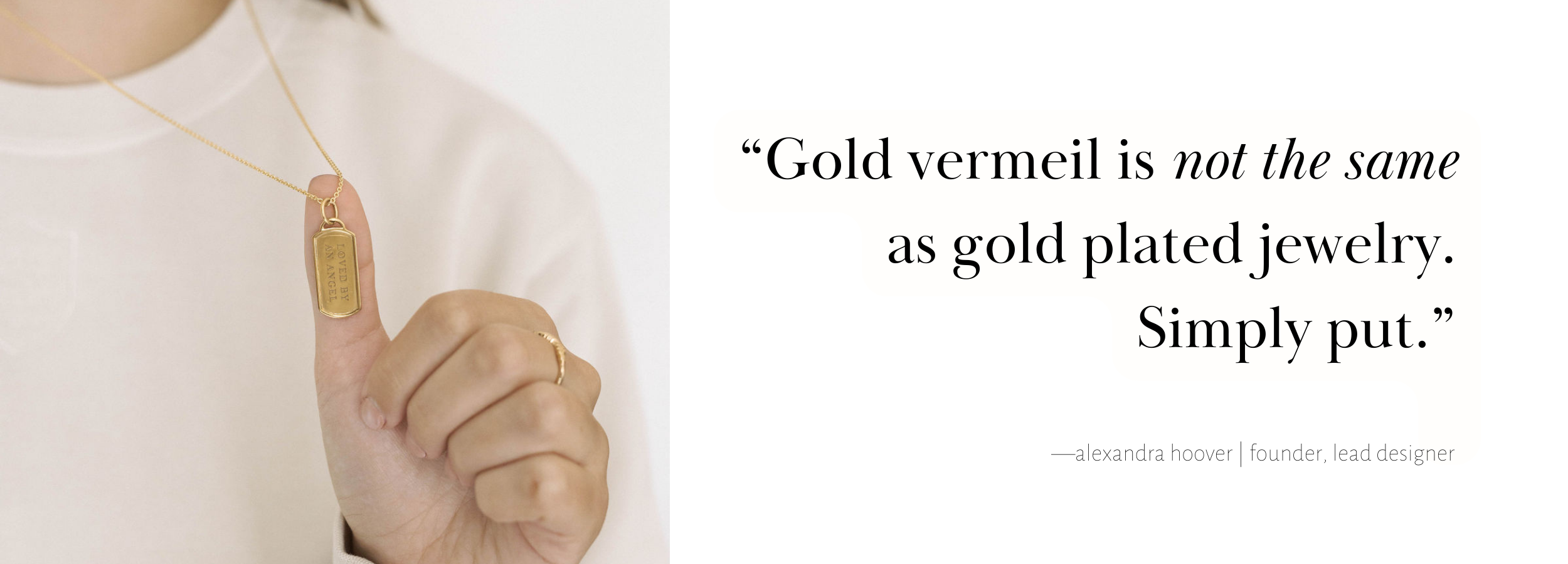Gold Vermeil
What is gold vermeil?
Gold vermeil is a French term (pronounced vehr-may) that is used to define the highest quality process of gold plating for jewelry. Due to the strict standards and qualifications required to classify jewelry as gold vermeil, the process is actually legally regulated in the United States.
To be true gold vermeil, a piece of jewelry must meet all of the listed conditions:
- Have 0.925 solid sterling silver as its base material | sterling silver is an alloy made of 92.5% pure silver and 7.5% other materials, and is a standard material used in high quality jewelry (versus, e.g., brass or copper).
- Be plated in a gold layer that is at least 10k (10 karats). That means the gold is at least 41.7% gold content | we exceed this quality requirement by only offering a plating of 14k gold
- Have gold plating that is at least 2.5 microns thick | a micron is 1/1000th of a millimeter.
What is 14k gold vermeil?
While gold vermeil 14k gold vermeil is jewelry that has been plated with a thick layer of 14k gold over a sterling silver base. 14k gold is composed of 58.3% pure gold and 41.7% other metals. Jewelry makers prefer 14k gold for the outer plating rather than 100% pure gold (aka 24k gold) because pure gold is very malleable and has very strong yellow and orange tones, which give it a brassy look.
Is gold vermeil the same as gold plated jewelry?
Gold vermeil is not the same as gold plated jewelry. Simply put.
The main differences between gold vermeil and gold plated jewelry are the thickness of the gold plating and the base metal used. Gold plated jewelry has plating at least 0.5 microns thick — 5x less than gold vermeil.
Gold plated jewelry does not require a sterling silver base — it usually uses inexpensive materials, such as copper or brass as its core metal. Since the layer of gold is so thin, the gold plating tends to wear off very quickly, which can cause the jewelry to degrade at a faster speed.
What does this mean for you? Gold vermeil is superior to gold plated jewelry in terms of longevity, quality and value, and is recognized in the jewelry world as fine jewelry.
Is gold vermeil good quality?
After solid gold, gold vermeil is the highest quality type of gold tone jewelry that you can buy. It is a great option for those who are seeking an affordable and high quality alternative to solid gold jewelry, which is ultimately the reason we choose to offer it as a selection for our customers.
Gold vermeil jewelry uses a thick layer of gold plating over a solid .925 sterling silver base, while stankard gold plated and gold filled jewelry use a thin layer of gold over brass or copper as their base metals. They are susceptible to tarnish, and the thin layer of gold will wear off quickly, leaving the unattractive metal to show through.
If you are looking for a sustainable option for jewelry but cannot afford solid gold, gold vermeil is your next best choice.
Does gold vermeil wear off?
In short, yes - gold vermeil can wear off after heavy use. However, with proper care, the thickness of the plating can allow the piece to last for many years.
While gold vermeil is considered resistant and durable, like all alloyed gold, with typical wear and use, the metal can naturally start to fade over time. We partner with industry leading manufacturers to provide the best plating available on the market, so don’t expect this to happen anytime soon. All of our solid .925 sterling silver foundation tags are plated and regulated in the United States.
How can I maintain the longevity of my jewelry?
You may be wondering, what can I do to ensure my jewelry lasts as long as it is supposed to?
Keep your jewelry safe by putting it on last. Getting ready can involve things like sprays and lotions that, even when healthy for our skin and hair, can contain elixirs that are damaging to our jewelry. Products like perfume and hairspray, are especially harsh.
Jewelry (just like everything) is made up of atoms and molecules that react with the substances that they come into contact with. So, even if you don’t notice anything right away, frequent exposure to chemicals will cause micro changes in the surface of your jewelry that become visible over time.
What to do?
- Wait a minute after applying lotion, perfume, or make-up, and wash your hands before donning your jewelry.
- If you forget and douse yourself with a generous spritz of perfume after you’ve donned your jewels, use a clean, damp cloth to wipe off the residue as soon as possible.
Shop our gold vermeil foundation tag



Created to honor angels, The LOVED BY AN ANGEL™ Foundation Tag provides a timeless, lasting way to remember those we have loved and lost. Boasting a high polished, mirror like finish, the foundation tag is sure to catch light at every turn - drawing attention to the cherished story for which these words represent. As something that will be worn proudly day after day, we've created a piece that is just as durable as it is beautiful, that will withstand the test of time - for generations to come.
Metal 14k Gold Vermeil
Chain Selection no chain | The Cable Chain | The Paperclip Chain
learn more about our chains
Tag Measurement approximately 1.14” x 0.51” plus 0.3” jump ring
We stand by the quality and construction of our jewelry. Please read more about gold vermeil to understand how to best care for your piece, adding to its longevity.


